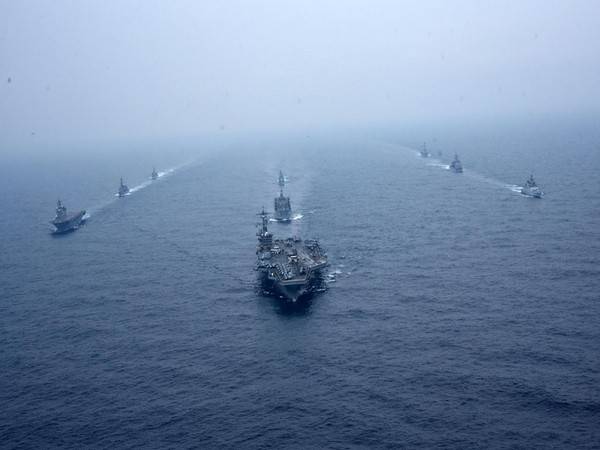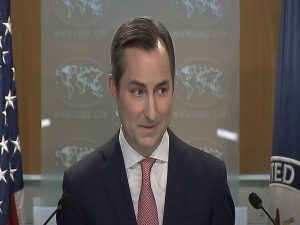Indian Ocean, according to a analyst, is the “epicenter of Indo-Pacific” and any policy regarding the Indo-Pacific will necessarily include the Indian Ocean because it provides opportunities for outreach to Africa on one hand and South East Asia on the other, thereby facilitating the integration of the Indo-Pacific, writes Darakhsha Qamar
The 6th Indian Ocean Conference took place on the 12th and 13th May in Dhaka, Bangladesh. As the current chair of the Indian Ocean Rim Association, Bangladesh hosted the event and Bangladeshi Prime Minister, Sheikh Hasina, inaugurated it.
The Conference was started in 2016- having being previously hosted in countries like Singapore, Sri Lanka and Vietnam- and has since then become an important platform for all the countries in the Indian Ocean Region to come together, consult and cooperate with one another to ensure peace, prosperity and stability in the region. In fact, it has become instrumental in the implementation of India’s Security And Growth for All in the Region (SAGAR) initiative. The theme of the conference this year was “Peace, Prosperity and Partnership for a Resilient Future,” and it was attended by guests from 25 countries.
The strategic importance of the Indian Ocean cannot be stressed upon enough. Its trade routes have been facilitating the flow of goods, people and ideas between the areas of Asia- pacific and North Atlantic since ancient times. It retains its position of eminence today as an important trade route that has a major portion of the world’s crude oil supply passing through it. The Indian Ocean Region (IOR) is also rich in mineral resources as well as a massive drainage basin that is home to some of the fastest growing economies in the world as well as a large chunk of the world’s population. This region is brimful of potential and greater regional integration can transform this region, turning it into a thriving economic hub.
It is, however, this very inability to cooperate effectively with each other as well as the inability to put broader regional and global interests before narrow national interests, that has resulted in the IOR facing security threats from non-state actors such as smugglers, pirates and terrorists.
The Indian Ocean of course has great strategic significance for India, which is the most populous state and one of the biggest powers in the IOR. India has 7500 Km of its coastline in the Indian Ocean and is dependent on it for energy imports through the Indian Ocean route, which is why India has a major stake in the security and development of the IOR. India also realizes that it cannot achieve this vision of a secure and stable Indian Ocean on its own and has been seeking to enhance cooperation and connectivity amongst the states in the region.
In fact, the SAGAR initiative, which serves as India’s policy towards the Indian Ocean, was introduced, just like the Indian Ocean Conference, in 2016, and aims at ensuring the maritime security of the states of the IOR. At the same time, it also promoted economic partnerships as well as collaboration in matters of tourism, infrastructural development and laying the groundwork for sustainable development in the region.
The Indian Ocean Conference thus has become a major facilitator of India’s ambitions regarding the IOR. This was evident during India’s external affairs minister, S. Jaishankar’s keynote address at the conference, where he stressed on the need for enhanced connectivity in the region and the restoration of ancient links between the countries of the region that had been disrupted by imperialism. He talked about the importance of India developing land connectivity with South East Asia and multi-modal connectivity with the Gulf and Central Asian countries. He also emphasised that India is prioritizing connectivity with ASEAN, as that, in his words, “will be a game changer.” Further on in the speech, he said that ensuring maritime security is a shared responsibility and it would require all the countries in the region to exchange information and cooperate with one another for coastal surveillance and collaborating on Maritime domain awareness (MDA).
Most importantly however, Jaishankar stressed on the significance of the Indian Ocean as a central component of the Indo-Pacific region and therefore the challenges being faced by IOR countries cannot be undermined and needs to be dealt with properly, if the vision of a free and inclusive Indo-Pacific is to become a reality. This was reiterated by author, leading South Asian strategic analyst and founder of StratNews Global, Nitin Gokhale, who was a guest at the 2 day conference in Dhaka.
Gokhale told India Narrative that the Indian Ocean is the “epicenter of Indo-Pacific” and any policy regarding the Indo-Pacific will necessarily include the Indian Ocean because it provides opportunities for outreach to Africa on one hand and South East Asia on the other, thereby facilitating the integration of the Indo-Pacific. Further, speaking on the significance of Bangladesh hosting the event, and it’s importance in the overall Indo-pacific, Gokhale said that considering the fact that Bangladesh is “the epicenter of the epicenter (the Indian Ocean), it is but natural that Bangladesh should host the Indian Ocean Conference.”
He also pointed out that having released its Indo-Pacific Outlook last month, Bangladesh has sought to take center stage in supporting a peaceful and inclusive Indo-Pacific for all and can in fact be instrumental for outreach to the pacific as well as the Indian Ocean.

BBIN and South Asian railway network
The Indian railways recently completed the survey for the feasibility of a railway line connecting Kokrajhar in Assam, India, to Gelephu in Bhutan. During the Bhutanese King Jigme Khesar Namgyel Wangchuck’s visit to India, both the countries engaged in talks where they sought to prioritise enhancing connectivity between the two countries, mainly by expediting the completion of the above mentioned rail link. The first stage of the primary engineering work is reportedly complete and there all already talks to connect other regions through the railway network, such as Samtse, Phuentsholing, Nganglam and Samdrupjongkhar.
This news comes amidst the BBIN (Bangladesh, Bhutan, India and Nepal) countries’ renewed interest in using transnational railway networks as an important tool of regional integration in the sub-region. The pre-requisite to economic development anywhere is good connectivity and the BBIN countries have sought to, over the years build a trans-regional communication and transportation infrastructure. The most significant part of this infrastructure is the building and in some case resuscitation of railway networks between the BBIN countries.
Railways networks connecting South Asian countries is not a new phenomenon since there were many railway routes connecting India and Bangladesh since colonial times. The renewed interest in railways can further, also be attributed to the fact that railways are the most climate-efficient option for the movement of goods and people over long distances. It would lead to reduced carbon emissions for the BBIN countries and therefore the entire sub-region.
Apart from Bhutan, the other 3 countries are connected to each other by at least one railway line and the railways have good connectivity with ports facilitating trade in and through the sub-region. Bhutan, where roadways have been the main mode of transportation, does not have an operational rail network, but has been for some time considering developing a railway network for greater connectivity within the country as well as with its neighbouring BBIN countries. In fact it also signed a MoU with India in 2005 to develop, and set up five railway lines connecting both the countries.
That plan however did not come to fruition all these years, until now. India’s decision to proceed with the much delayed railway connectivity project with Bhutan, comes at a time when Chinese presence along the Line of Actual Control has been increasing steadily. In such a climate, this railway link could be instrumental in enabling India to secure its borders against China.
The first ever passenger rail link between Jaynagar, India and Kurtha in Nepal too was inaugurated only last year. The only other railway line is between Raxual (India) to Sirsiya (Nepal), but is mainly used for freight movement. Nepal, like Bhutan is a landlocked country and has much to gain through the development of railway connectivity.

It could lead to the relaxation of roadway traffic in these countries and reduce trade dependency on roadways. Further, access to low-cost railway services would also help both the countries to trade in resources and products that are not feasible to be transported through roadways. Nepal also has plans to develop a 1024km long East-west corridor that would connect, through a rail network, 24 districts spanning the entire length of Nepal, from Kakarvitta, in Jhapa district to Mahendranagar, in Kanchapur district. This project is expected to produce big economic returns for Nepal, by generating employment and enabling simple and cost effective movement of people and goods across Nepal.
There are currently, five operational railway links between India and Bangladesh and the most recent one to be resuscitated is the Haldibari (West Bengal) to Chilahati line, which had stopped being in operation since 1965. This line is expected to increase railway access to main ports and dry ports in order to bring about economic development and social upliftment of the entire region, including Assam.
Further, it is expected to better connect this region to the rest of the country through the Siliguri Corridor. The other rail lines, used variously for passenger and freight travel, are, The Petrapole-Benapole line- through which, an estimated 70% of the trade between India and Bangladesh takes place; The Gede-Darshana line, which falls within the proposed route of the Trans-Asian Railways and could help connect North-East India to South-East Asia; the Singhabad-Rohanpur line and The Radhikapur-Birol line.
Furthermore, the recently constructed Padma Multipurpose Bridge in Bangladesh is also expected to strengthen the physical connectivity between the two countries.
The four states making up BBIN, with their geographically contiguous borders and cultural links rooted in a common past and a long history of intra-regional trade and people to people connections, together form a South Asian Growth Quadrangle. Due to the interdependent nature of these states in political, cultural and economic matters, there is immense potential for overall economic development through increased connectivity and cooperation with each other.
Initiatives promoting greater regional connectivity, such as the- in some cases developed, in others proposed- transnational railway are mutually beneficial for all parties involved, providing them with an opportunity to utilise shared resources in a sustainable and rewarding manner allowing skill, as well the possibility of technology and knowledge transfer from more developed states to less developed states.
It also provides a way for smaller countries to hold their own and secure their own interests- with the help of its regional allies- in the midst of great power politics, resulting in the development of the entire region as a whole. India has long understood this and has, especially in the last decade, made the BBIN initiative a priority and an important part of its sub-regional diplomacy efforts.
Not only does India seek to build sub-regional connectivity through BBIN, it also hopes to leverage this sub-regional partnership to develop connectivity with South East Asia.
The geographical proximity and sharing of borders of these countries with India’s north-east would also provide a way to develop the whole of north-east through cross-border efforts, as well as increase its accessibility vis-a- vis the rest of the country. In such a context, the development and resuscitation of cross-border railway networks is expected to transform connectivity in the BBIN region. And as we now understand, stronger ties between the states would only lead to greater peace and stability in the region, with each country being able to pursue their individual security interests while prioritising collective economic development.






